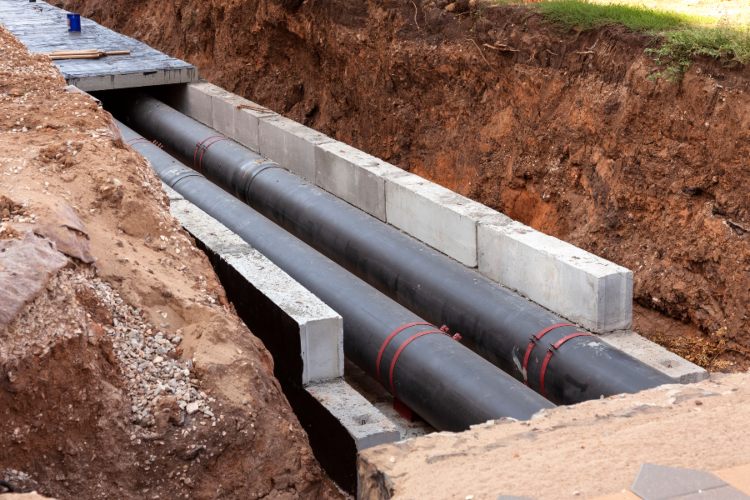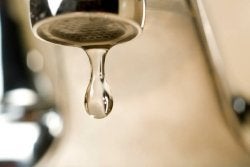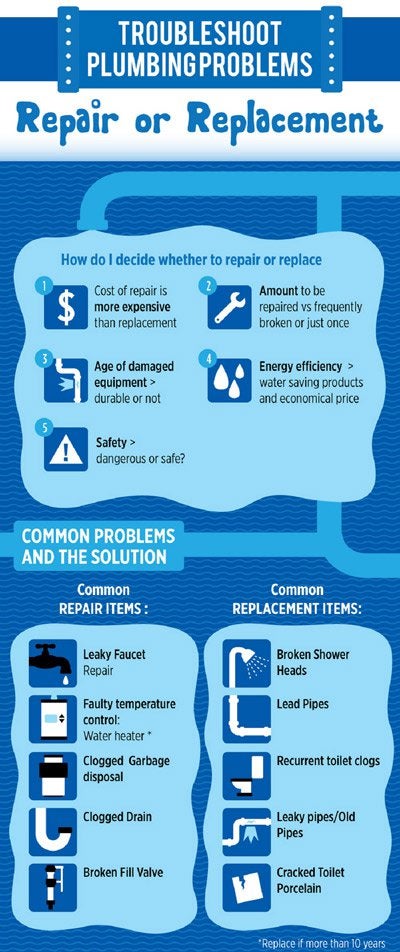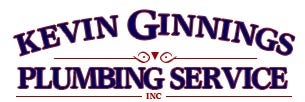How Far Below the Surface Must a Water Line Be Buried?
When installing or repairing water lines, one question often comes up: How deep should they be buried? Proper burial depth prevents freeze damage and ensures that your water line stays operational throughout the year.

The Importance of Water Line Burial Depth
The correct burial depth for a water line is important for several reasons. Water lines that are too shallow are vulnerable to freezing in cold temperatures and may suffer from damage due to the weight of the earth above them or from landscaping activities. On the other hand, burying a water line too deep can lead to higher installation and repair costs without necessarily offering extra benefits. By finding the optimal depth, you can:
- Prevent Freezing: When water inside a pipe freezes, it expands, potentially causing the pipe to burst. Buried deep enough, pipes are protected from freezing temperatures.
- Reduce Accidental Damage: Water lines buried at the right depth are less likely to be damaged by common yard maintenance, construction, or landscaping activities.
- Maintain Water Flow: Pipes that freeze or crack can cause disruptions in water service. Correct burial depth keeps water flowing consistently.
Proper depth ensures your water line is protected year-round, preventing costly repairs and maintaining the flow of water to your home or business.
How Frost Depth Impacts Water Line Burial
One of the most important factors when determining the water line burial depth is frost depth. Frost depth refers to how deeply the ground freezes during the winter months, and it varies based on climate and soil type. In South Kansas City, the frost depth typically reaches about 36 inches, though unusually cold winters can cause it to go even deeper. Frost depth is significant because water lines installed above the frost line are at risk of freezing and bursting during cold spells. Water lines should be buried six to twelve inches below the frost line to provide an added layer of security against unexpected cold snaps. For South Kansas City residents, this means burying water lines at least 42 inches deep. However, each property is unique, so it’s wise to consult a plumbing professional who can assess your specific conditions.
Factors That Influence Water Line Burial Depth
While frost depth is the most important consideration, several other factors should be considered when determining how deep to bury a water line. Some of the key considerations include:
- Local Regulations: Building codes vary by municipality, and South Kansas City may have specific regulations governing the minimum and maximum burial depth for water lines. Local codes ensure consistency and safety, so be sure to follow them closely. Kevin Ginnings Plumbing makes sure your work is compliant.
- Soil Composition: Soil density plays a significant role in how well the ground insulates water lines. Dense, clay-like soils retain heat better and may not require as deep a burial as sandy or rocky soils, which allow more rapid temperature fluctuations. Kansas City’s varied soil types make it important to assess the soil composition before deciding on a burial depth.
- Water Line Materials: Different pipe materials have varying degrees of durability and tolerance to temperature changes. Materials like copper and PEX are popular due to their strength and resistance to freezing, while some types of PVC may require deeper burial to prevent freezing.
- Weight and Surface Load: If you plan to install a water line under a driveway, parking area, or other locations that bear heavy loads, you may need to bury the line deeper to prevent it from cracking under pressure. The added depth will protect it from the additional weight and stress.
- Potential for Future Landscaping: Anticipating any future landscaping projects can also influence burial depth. If you foresee digging in certain areas, it’s wise to either mark water line locations carefully or opt for deeper burial to reduce accidental interference.
Finding and Repairing Water Lines
Locating an existing water line for maintenance or repair can be tricky, especially if you’re unsure of its depth or placement. At Kevin Ginnings, we use specialized equipment to detect buried water lines without unnecessary digging. This technology allows us to accurately locate water lines using tools like ground-penetrating radar and tracer wires, our team can pinpoint the exact location of water lines, minimizing disruption to your yard or property. Once located, we can identify the issue and offer a targeted repair solution. Trying to locate or dig up your own water line can lead to damage and potential injuries, especially if the line is pressurized. We make sure the job is done safely and accurately.
Key Insights to Remember
Before embarking on any water line installation or repair, here are some takeaways to remember:
- Frost Depth Matters: The local frost depth (around 36 inches for South Kansas City) determines how deep to bury water lines.
- Comply with Local Codes: Local regulations set minimum burial depths, ensuring water lines remain safe from freezing and accidental damage.
- Assess Environmental Factors: Soil type, pipe materials, and surface loads all impact the ideal burial depth for your water line.
- Hire a Professional: Accurate installation requires the right tools and expertise. Kevin Ginnings Plumbing will ensure your water lines are installed correctly and according to code.
Contact Kevin Ginnings Plumbing
Whether you’re installing a new water line, conducting repairs, or simply curious about water line burial depth, the team at Kevin Ginnings Plumbing has you covered. As South Kansas City’s trusted plumbing service provider, we bring years of experience, local knowledge, and industry expertise to every job. We can evaluate your property’s needs, ensure compliance with local codes, and deliver solutions to keep your water lines secure and functional. Contact us today for a free estimate.
Ask the Inspector: Plumbing Checkup
 By Rich Duerkop
By Rich DuerkopWhat should I be aware of about the plumbing in my home, both new and older construction?
You should frequently check all faucets and other valves for leaks.
Turn the water on, look under the sink, and run your hand around the shut-off and drain pipes to make sure they are not leaking. Then go down to the basement and check for leaks. A good way to remind yourself is to mark your calendar and check these areas every change of the season.If you see any water staining in the walls or the ceiling call a licensed plumber right away.
If your water pressure in an older home appears marginal or poor remember your old pipes may be corroded. I have seen pipes so full of corrosion the opening is no bigger than the lead of a pencil. When pipes get like this the only thing you can do is call a licensed plumber and have them removed.
When you check the toilet listen for hissing sounds that may indicate that it is running and wasting water; new parts may need to be added. If the toilet is loose I would recommend you pull the toilet, evaluate the floor, and replace the wax seal.
In older homes, if you have an old toilet I would recommend replacing them. Some of the old toilets would flush on five gallons of water where the new ones flush on about a gallon and a half. This is a real water saver.
To help extend the life of your water heater drain off about three gallons of water out of the faucet at the lower part of the heater. This helps remove sediment that builds upon the bottom of the tank. I would do this about every three months.
Everyone in the house should know where the main water shut-off is, in case you have to shut off the water to the whole house if there is an emergency. I recommend tagging the valve so it is easier to find especially for children.
Check all shut-off valves throughout the house for leaks. In older homes many times there are no shuts-offs under the sinks and other water lines. I would recommend installing them; that way you can turn off the water right at the source of the leak instead of having to run down to the basement to close the main shutoff.
Did you know? We are a Best Plumbers Award Winner!
You will receive excellent results working with master plumbers from Kevin Ginnings Plumbing Services. Our commercial and residential plumbing company is backed by more than 30 years of experience, and we have proudly served the area for more than 28 years.
The most trusted plumbers in the Kansas City, Overland Park & all of Johnson County. From plumbing fixture upgrades to complete system maintenance and repair, we are here for all of your residential and commercial plumbing needs.
Professionally trained Kansas City plumbing technicians come to your home or business in uniforms to bring you honest and reliable plumbing services every time. Rely on our plumbing professionals in Kansas City for commercial and residential plumbing services.
Kevin Ginnings Plumbing is a full-service plumber that has served the Greater Kansas City area for 3 decades. Our goal: provide fast, high-quality plumbing services for our customers in the Kansas City area.
Kevin Ginnings Plumbing has been providing a full range of plumbing services to customers and communities all across Greater Kansas City & Johnson County, Kansas. Our plumbers are experienced in all aspects of plumbing repair in Kansas City.
Please contact us for additional information or to schedule a service appointment.
Troubleshooting Your Plumbing Problems

Spike in Your Monthly Water Bill
If you’ve seen an upsurge in your recent monthly water bill, the most likely culprit is a leak in your main water line. Without expert service and repair, you will literally throw money down the drain—not to mention the bigger problems the leak will create as it just grows into flooding of your home or business or a dreaded pipe burst.
Trench-less Technology – Pipe Bursting
In many cases, we can provide you with breakthrough trench-less technology to replace your waterline. Trench-less water line replacement;
- is much more economical
- involves less mess and expense of tearing up your driveway or yard
- takes much less time to accomplish
- offers much less of an environmental footprint
Equipped to solve your waterline problems, 24/7 in the Kansas City area. Our skilled phone and service technicians can quickly hunt down the source of your problem and detail for you the proper solution. We are expert at solving a variety of waterline problems, such as:
- Waterline repairs
- Replacement of damaged pipes
- Redirection of the flow of your current piping system
- and more
Waterline bursts and broken pipes won’t search out a perfect time in your schedule. We are available 24 hours a day, seven days a week, to be at your side to help when water floods your home or business. Our expert technical representatives can, over the phone, walk you through the troubleshooting and shutting off your water main to stem the flow of water into your structure. Next, we send out our technicians to your home to diagnose and cure the problem. Because we’re there for you 24/7, we can remedy your predicament and get you back to a dry, normal life. We take pains to equip our techs’ trucks with all the latest parts, tools, and supplies to maximize our ability to solve your problem in one visit, if possible.
The Dangers of Water Heaters
Classic video on the potential dangers posed by unprotected water heaters. Demonstrates the explosive power of water heaters and the need for temperature & pressure relief valves. This Video is one of Watts instructional videos.Lead free updates from the EPA
By Shawn Martin
While the “Reduction of Lead in Drinking Water Act” was signed in early 2011, the story on it continues to unfold. The law is set and has not changed, but the U.S. Environmental Protection Agency (EPA) continues to release guidance detailing their interpretations of the law. Most recently, the EPA has released two documents designed to clarify questions on its applicability and implementation and to assist contractors, designers, and inspectors.
A document, “How to Identify Lead-Free Certification Marks for Drinking Water System and Plumbing Materials,” was released by the EPA in September 2013. It provides a user-friendly flow chart describing the decision-making process that should be used to determine whether a product must comply with the law. It also addresses certification marks that may be used to show compliance with the law.
Many examples of marks used by third-party certification agencies, such as ICC-ES, NSF, and CSA, are provided in the document, along with explanations on their use. But, the document also clarifies the fact that third-party certification of a product is not required, nor is there a single, uniform mark showing compliance. The document is available on the EPA website as a PDF download.
A second, more technical document, “Summary Of The Reduction Of Lead In Drinking Water Act And Frequently Asked Questions,” was released by the EPA in October 2013. This document followed a draft frequently asked questions (FAQ) document released in May 2013. The EPA sought comments on that draft through June 2013, and many individuals and organizations responded. The final version contains a number of revisions as a result.
Probably most notably, the FAQ document stated that water heaters and dishwashers (FAQ #6) and fire hydrants (FAQ #5) must comply with the new lead free requirements. It also provided updated information on the repair of various types of devices (FAQ# 23-30), including those installed before and after January 4.
Taken together, these documents provide the best available information from the EPA on its interpretation of the law. The FAQ document is a must-read for plumbing inspectors, contractors, distributors, manufacturers, designers and engineers. It should also be noted, though, that the EPA is still requesting feedback on the documents and other revisions are possible. So, it is important for all in the industry to continue to monitor developments.
Many channels are available to keep tabs on this law as it is implemented. For those who are ICC members, they can subscribe to the PMG Membership Council free of charge to receive updates as they become available. ICC also provides links to these key resources on its PMG homepage under the Resources tab, and makes every effort to keep them up to date. ICC is also a member of the Get the Lead Out of Plumbing Consortium, which provides a number of resources on the topic for different audiences. Distributors, such as Lowes and Ferguson, are working actively to push information to local stores, as national member organizations such as ICC, PHCC and ASPE are reaching out to chapters.
On the local level, states are still grappling with the law and working to determine how best to implement and enforce it. While the law requires that states enforce the installation prohibitions (and provides for a penalty if they do not), it does not specify the specific method they must use. Building and plumbing codes are suggested but not required. Without such a requirement in state or local code, however, many states are struggling to determine the appropriate enforcement authority. Efforts are underway in many jurisdictions to update local codes to require compliance with the new no-lead provisions. Model codes, such as the 2015 International Plumbing Code have been updated to comply with the new law and provide important resources for communities seeking to revise their codes.
So, in addition to monitoring the latest from the EPA, it is also important for those in the industry to monitor local plans for enforcement and rollout. States such as California, Maryland, Vermont and Louisiana have already passed state laws consistent with the new federal law, providing a framework for local implementation. Links to key documents from these states can also be found on the ICC PMG web page, under the Resources tab. It remains to be seen if other states will pass laws or move to revise codes seek to comply with the law.
It is critical that those in the plumbing industry continue to closely monitor federal, state and local developments related to the reduction of lead in plumbing products. Organizations such as ICC and the other members of the Get the Lead Out of Plumbing Coalition will continue to work to serve the industry with the best possible information, in a timely way as it is received.
Shawn Martin is the director of Plumbing, Mechanical, and Fuel Gas (PMG) Activities with ICC.
– See more at: http://www.plumbingengineer.com/jan_14/leadfree_feature.php#sthash.TkUEwCFr.dpuf
Fix a Running Toilet
WHY DO THIS?
A running toilet can waste two gallons of water per minute. That will do a number on your water bill this month. Plus, if you don’t repair it, your toilet can spring a major leak which can cost thousands of dollars to fix. And, of course, it makes a really annoying noise!
First, take off the toilet lid.
Flush the toilet. Pay attention to your chain and flapper. If your chain is tangled, that’s your problem! A tangled chain prevents the flapper from completely setting on top of the hole at the bottom of the toilet bowl. Untangle your chain, and flush your toilet again. If the flapper sits flush, your problem should be solved.
If your flapper doesn’t sit flush on the bottom of the toilet tank, you need to tighten your flapper. Do this by reconnecting the flapper to the bracket by tightening the pegs holding the flapper down. You can tighten the pegs with your hands.
If your flapper is secured, make sure it isn’t soft and spongy. If it is, it’s time to replace it. You can purchase a new flapper at your local hardware store for less than $10.
To replace your flapper, first turn off the shutoff valve. It’s located on the wall behind the toilet. Flush the toilet to remove the water in the bowl and then remove the old flapper by pulling it off the pegs on the bottom of the tank. Remove the chain from the old flapper with your needle nose pliers. To install your new flapper, simply reverse the steps to remove the flapper.
Turn your water back on by turning the shutoff valve back on. Let your toilet’s tank fill with water, and then replace your tank lid. Voila!
SOURCE: https://brightnest.com/todos/fix-a-running-toilet
